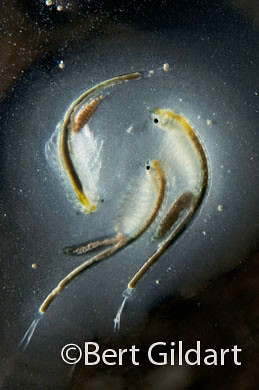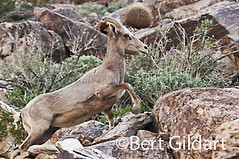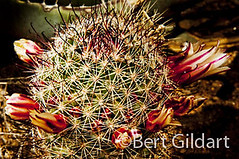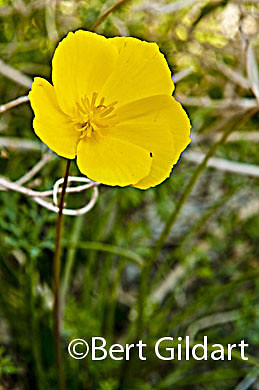More Phenomena at Anza Borrego Desert State Park
©Bert Gildart: Since my posting about fairy shrimp, I have learned more about this tiny crustacean by visiting with several of the volunteer naturalists at Anza Borrego Desert State Park. As I explained recently, rains dissolved the cyst that protects the species from the fiery sun and the desiccating winds. But what naturalists explained is that that all life-perpetuating functions are performed in a period of just two weeks.
Another interesting fact is that Native Americans once gathered fairy shrimp by the thousands collecting them in baskets woven so tightly that these half-inch long creatures could not escape.
Fairy shrimp then served as a source of food. Obviously the food source was marginal as rains sufficient to bring forth the large numbers Janie and I saw at Clark Lake several days ago only occur once every five or six years. This is one of those years.
SPRING FLOWERS
Rains in this park are also beginning to bring forth spring flowers, and there are two particularly showy species now blooming. One is a species of cacti known as the Fishhook Cactus, which can now be seen along the trail to the old Marshal South homestead in Blair Valley.
The other is a Gold Poppy and Eric Hansen and I photographed it yesterday while looking for sheep along the Palm Canyon trail. Eric and Sue are a husband wife writer/photographer team, also members of the Outdoor Writer’s Association of America, and Janie and I have known them for years. They’ll be here for a week or so.
To photograph the two species I used two different techniques. I photographed the cactus using two strobes lights, a technique described in other postings. I photographed the Gold Poppy by asking Eric to create a shadow over the plant, so reducing shadows that tend to be excessively contrast-y in the harsh desert light.
Eric and I are both interested in photographing the desert bighorn and, yesterday, we had some success, but it wasn’t easy. We departed our campground about six in the morning and were at the trailhead shortly thereafter. By sunrise we were a long way up the canyon when Eric spotted a ewe-lamb group on the side of Indian Head Mountain.
Bighorn sheep scurry along side of Indian Head Mountain; fishhook cactus now blooming along trail to Marshal South’s old homestead.
SHEEP WERE NONCHALANT
The sheep demonstrated but little concern and drifted toward us. Half an hour later we were close enough to perch on the side of a rock and allow them to acclimate further to our presence, which they did. Several minutes later several moved even closer toward us. Then, they began scampering around as though in play. Two of the young rams began a mock battle of head butting, but all that occurred behind a patch of creosote.
Though the images I did obtain were not exceptional, I was delighted that I could document these magnificent animals in the rugged setting which has been their home for centuries. It is my hope to amass a portfolio of desert bighorn and with ones taken here several years ago, believe I am beginning to achieve that objective. Borrego, of course, means sheep, so while here the effort as a photographer seems appropriate.
————————————————————————————-





